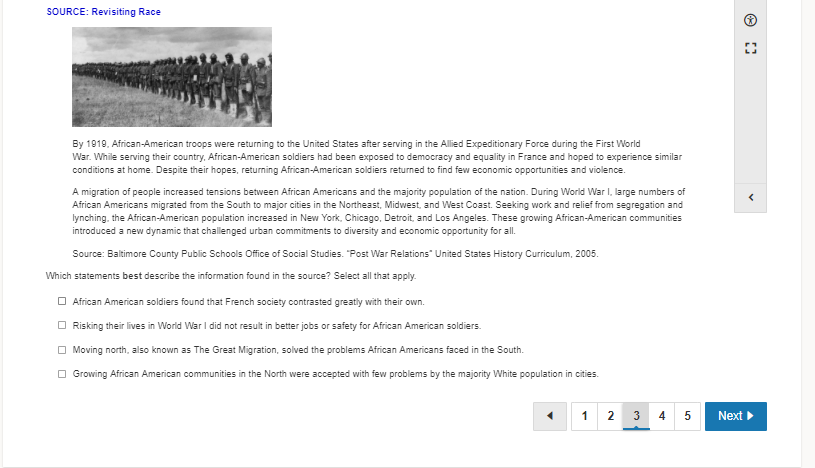SOURCE: Revisiting Race By 1919. African-American troops were returning to the United States after serving in the Allied Expeditionary Force during the First World War. While serving their country, African-American soldiers had been exposed to democracy and equality in France and hoped to experience similar conditions at home. Despite their hopes, returning African-American soldiers returned to find few economic opportunities and violence. A migration of people increased tensions between African Americans and the majority population of the nation. During World War I, large numbers of African Americans migrated from the South to major cities in the Northeast, Midwest, and West Coast Seking work and relief from segregation and lynching, the African-American population increased in New York, Chicago, Detroit, and Los Angeles. These growing African-American communities introduced a new dynamic that challenged urban commitments to diversity and economic opportunity for all.
SOURCE: Revisiting Race By 1919. African-American troops were returning to the United States after serving in the Allied Expeditionary Force during the First World War. While serving their country, African-American soldiers had been exposed to democracy and equality in France and hoped to experience similar conditions at home. Despite their hopes, returning African-American soldiers returned to find few economic opportunities and violence. A migration of people increased tensions between African Americans and the majority population of the nation. During World War I, large numbers of African Americans migrated from the South to major cities in the Northeast, Midwest, and West Coast Seking work and relief from segregation and lynching, the African-American population increased in New York, Chicago, Detroit, and Los Angeles. These growing African-American communities introduced a new dynamic that challenged urban commitments to diversity and economic opportunity for all.
Related questions
Question
SELECT ALL THAT APPLY

Transcribed Image Text:SOURCE: Revisiting Race
By 1919. African-American troops were returning to the United States after serving in the Allied Expeditionary Force during the First World
War. While serving their country, African-American soldiers had been exposed to democracy and equality in France and hoped to experience similar
conditions at home. Despite their hopes, returning African-American soldiers returned to find few economic opportunities and violence.
A migration of people increased tensions between African Americans and the majority population of the nation. During World War I, large numbers of
African Americans migrated from the South to major cities in the Northeast, Midwest, and West Coast. Seking work and relief from segregation and
lynching, the African-American population increased in New York, Chicago, Detroit, and Los Angeles. These growing African-American communities
introduced a new dynamic that challenged urban commitments to diversity and economic opportunity for all.
Surce: Baltimore County Public Schools Office of Social Studies. "Post War Relations" United States History Curriculum, 2005.
Which statements best describe the information found in the source? Select all that apply.
O African American soldiers found that French society contrasted greatly with their own.
O Risking their lives in World War I did not result in better jobs or safety for African American soldiers.
O Moving north, also known as The Great Migration, solved the problems African Americans faced in the South.
O Growing African American communities in the North were accepted with few problems by the majority White population in cities.
1
Next
2 3 4 5
Expert Solution
Step 1
There is a passage given in the question. It talks about the return of the African-American soldiers from the First World War. The passage describes that the African-American soldiers were on war with Allied Expeditionary Force and returned to the U.S. by 1919.
Step by step
Solved in 3 steps
